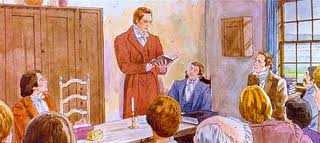School of the Prophets
Summary from the Joseph Smith Papers:
A term occasionally used to refer to a Protestant seminary; specifically used by JS to refer to a school to prepare elders of the church for their ministry. A December 1832 revelation directed JS and the elders of the church in Kirtland, Ohio, to establish the school. Their instruction was to include both sacred and secular topics. The school was organized on 23 January 1833 on the second day of a conference held in the upper room of Newel K. Whitney's store.
Members were initiated into the school by the ordinance of the washing of feet and met each other with a formal, prescribed greeting at each school meeting. JS presided over the school. The school was temporarily adjourned in April 1833 so the elders attending it could be sent on missions to raise funds to purchase property in Kirtland. On 1 June 1833, a revelation directed that the upper floor of the House of the Lord in Kirtland be used for the school. In October 1833, plans were made to house the school in the printing office building, which was to be built on the temple lot. A similar school, led by Parley P. Pratt, convened in Jackson County, Missouri, during summer 1833. In late 1834, ministerial training resumed under the name “Elders school” or “school for the Elders.” Although this school differed from the original School of the Prophets in that it did not include the foot-washing ordinance or the formal greeting, JS and others sometimes referred to it as a School of the Prophets. Additional sessions of the Elders School were held in winter 1835–1836.
Reference: The Joseph Smith Papers
From wikipedia [as of 8/20/13]:
In the early Latter Day Saint movement, the School of the Prophets (also called the "school of the elders" or "school for the Prophets") was a select group of early leaders who began meeting on January 23, 1833 in Kirtland, Ohio under the direction of Joseph Smith for both theological and secular learning. Historian Joseph F. Darowski has called attention to earlier Old Testament and Protestant precedents, stating that Harvard and Yale were both once commonly called schools of the prophets. The first meeting of the school was held at the home-based store owned by Newel K. Whitney. The school provided a setting for spiritual experiences and in-depth discussions of gospel principles. A series of seven lectures presented at the school were published as part of the Doctrine and Covenants in 1835 and later came to be known as the "Lectures on Faith." Another branch of this school existed under the direction of Parley P. Pratt in Independence, Missouri for a short while. Though the school went into a sort of recess, it is apparent Joseph Smith planned to revive it after the completion of the temple at Kirtland, Ohio.
Brigham Young began several schools of the Prophets during his tenure as church president, beginning in 1868 in Salt Lake City, Utah, and spreading to Provo, Logan, Brigham City, Spanish Fork, Nephi, Ephraim, American Fork, and Ogden. His successor, John Taylor, also organized such schools in Salt Lake City and St. George in 1883.
MODERN-DAY SCHOOL OF THE PROPHETS
The LDS leadership in Sweden has begun their own modern version of the School of the Prophets. See School of the Prophets-2013-Sweden
Back To Glossary



 RSS
RSS